Army of the future: SS troops and special forces
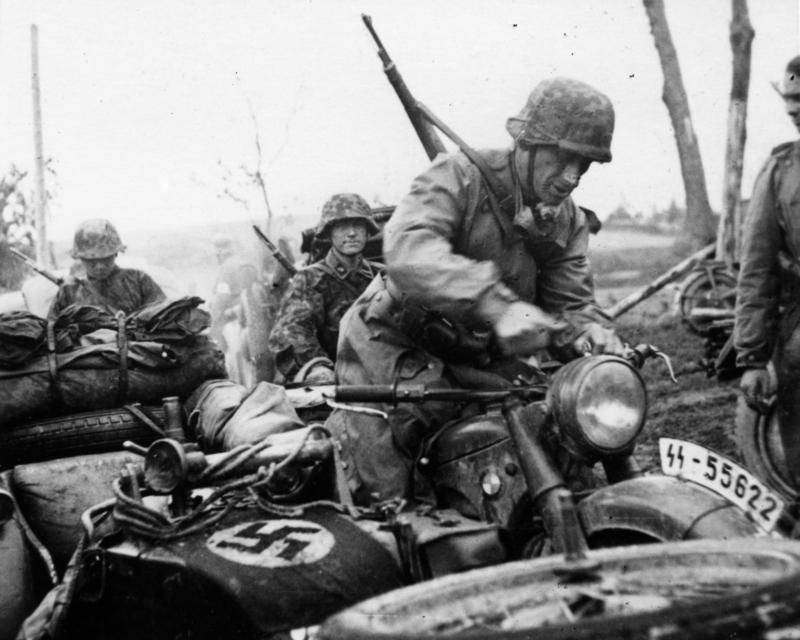
Servicemen of the "Dead's Head" division of the SS troops in the USSR in 1941
Innovators
The French made their main bet on the "Maginot Line" - a powerful line of fortifications on the border with Germany. The French generals assumed that the Germans would not be able to overcome it, at this time France would mobilize all forces, receive help from England, and a trench war would begin again, as during the First World War. The Nazis beat the enemy's headquarters with a blitzkrieg strategy, mobile formations simply bypassed the most powerful fortified areas of the enemy, broke through to the rear, and caused a wave of panic and horror. As a result, the French garrisons surrendered already in the deep rear of the German army, or the fighting was going far away from the French strongholds.
The Russians had little or no experience of fighting a modern, high-tech enemy before the start of the Wehrmacht invasion. In the Civil War, they fought with their own, aircraft and tanks there were few, the main role in the offensive, the breakthroughs of the front was played by the cavalry. The war with Poland was also fought and ended in defeat. In the 1929 operation on the Chinese Eastern Railway, we had to deal with weak Chinese troops. In Spain, the enemy was serious - the Italians and the Germans, but not the entire army was tested there, but only a group of military experts. The conflict on Lake Hassan with the Japanese was minor.
Only on Khalkhin Gol in the summer of 1939 did Soviet (Russian) troops collide with a modern army, which had a lot of aircraft, armored vehicles and artillery. The Japanese army was well trained, disciplined, and had extensive military experience. The Japanese in the Mongol steppes were utterly defeated, and as a result, the Japanese ruling elite decided that it was necessary to first solve the problem of defeating the enemy and seizing resources in the southern seas, and only then go to beat the northern barbarians.
Khalkhin-Gol made Soviet generals self-confident. Like, "the armor is strong, and our tanks are fast." Everyone believed that we would beat the enemy on his territory, and victory would come with little bloodshed.
Although, already in the battle with the Japanese army, the mistakes of the Red Army were noted: the Japanese at first dominated the sky and calmly bombed our troops; control of the battle on our side was unsatisfactory, interaction was not established; arriving troops and reserves were thrown into battle in units; mistakes of some led to unjustified losses of others (the heroism of some is a consequence of the negligence and stupidity of others). Obviously, the Wehrmacht would not forgive the Russians for such mistakes.
And so it happened in the harsh months of 1941-1942.
The war with Finland made its own adjustments. However, the enemy was defeated, the strategic task of strengthening the defense of the northwestern part of the country and Leningrad was solved. Therefore, the overestimation of their strengths remained.
Thus, the Westerners, that the Russians fought according to the old schemes, believed in the "lines of Maginot, Molotov and Stalin", in the number of tanks and aircraft. The Germans severely punished us for this. We were shown a new war, swift, with excellent interaction of armored forces, aviation, artillery, intelligence and special forces.
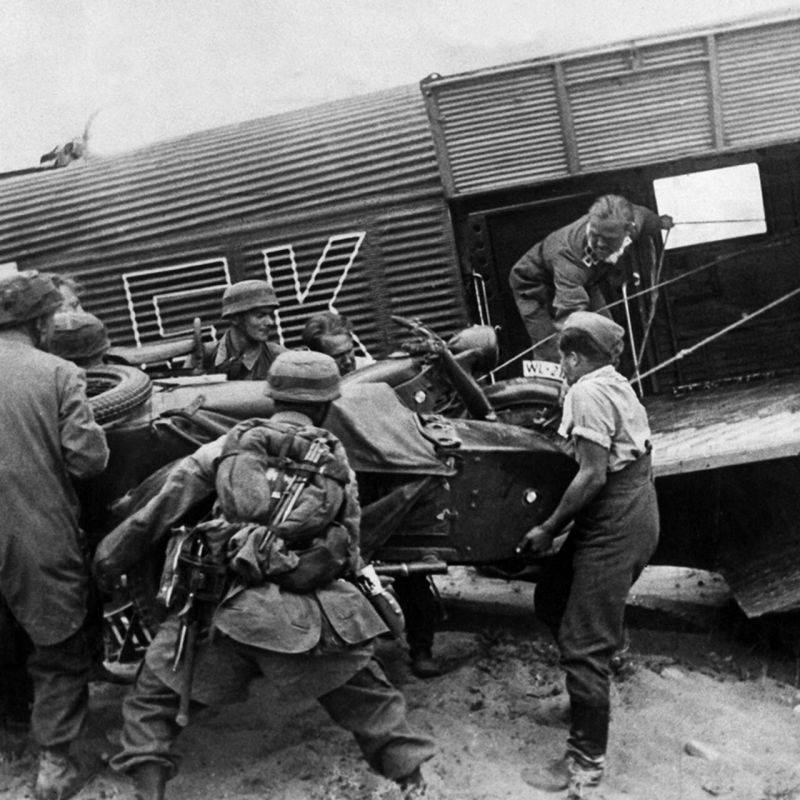
German paratroopers unload a BMW R-12 motorcycle from a Junkers Ju 52 transport aircraft in Crete. May 52
Wehrmacht soldiers
Since the 1920s, the Germans abandoned the traditional methods of training soldiers, did not torture them with marches, drill and kitchen outfits. Therefore, Hitler's army was qualitatively different for the better, even from the Kaiser's army, which was very good and powerful. She was imbued with the philosophy of invincibility, self-confidence, which was proven in the Polish, Norwegian, French, Yugoslav and other campaigns. Swift and victorious. The army was confident in its strengths, commanders, commanders.
The soldiers had comfortable uniforms and equipment. Wehrmacht soldiers were taught to fight, they were not peacetime soldiers, but fighters. They were given as many cartridges as they wanted to shoot. They learned to drive motorcycles, cars, armored personnel carriers. Handle the radio. That is, what was taught in other armies only in special, special units.
The secret of the German Lightning War lies in the excellent interaction of different types of troops. German veterans in their memoirs praised the Luftwaffe more than once. They cleared the way for tanks and infantry at the beginning of the war, smashed defensive positions and columns of the enemy trying to counterattack or retreat to new positions. The German Air Force remained operational until the very end of the war, supporting and rescuing its infantry. All this is the result of exercises in peacetime!
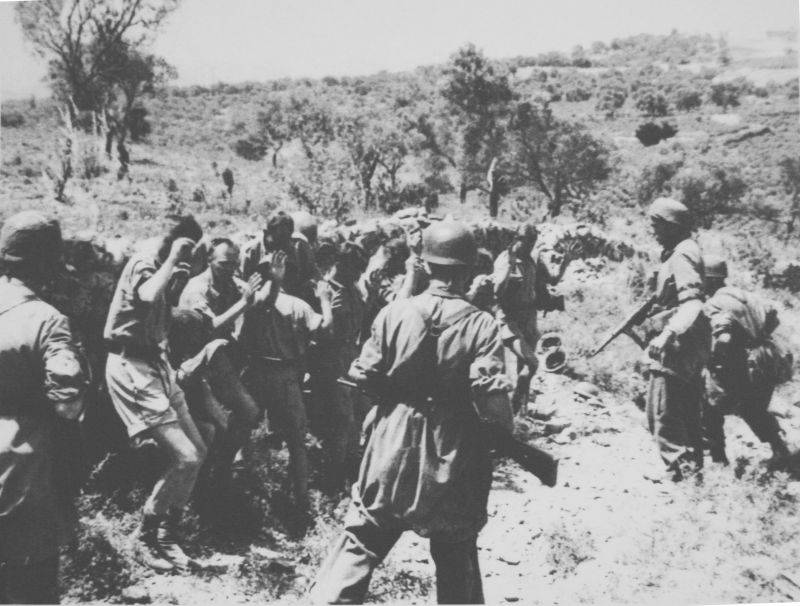
German paratroopers and a group of captured British soldiers in Crete. May 1941
Elite - SS troops
The Wehrmacht was not enough for Hitler.
He created a "reserve army" - the SS troops. First, as "security detachments" (German SS, abbr. From German Schutzstaffeln "guard detachments"), then as a full-fledged, elite army.
One of the creators and leaders of the SS troops, General Paul Hausser (Gausser), prepared his troops for quick attacks. Such an approach, according to Hausser's aide, Colonel Felix Steiner, requires "a flexible, adaptable type of soldier, physically strong, with increased endurance."
Most of the candidates who entered the cadet schools had already been selected by the SA, SS or Gestapo, were recommended by their commanders. First, the cadets learned to master weapons, underwent physical training (obstacle course), etc. Then they studied at a higher level, including field communications, interaction between infantry and artillery, landing on the enemy's coast, received the ability to command small units. The goal was to train independent, proactive leaders, the future elite of the Third (world) Reich.
Thus, the SS troops were solving two main tasks.
Along with the previous army, a new one was created, even more modernized, with increased mobility and combat capability, personally loyal to the Fuhrer, ready to carry out any order and die for the leader.
At the same time, an alternative mechanism for the formation of the Reich elite was created. The bravest people, loyal to the idea and the Fuhrer, were promoted to the top, regardless of their origin. Thanks to the SS, the masters and officers of the new German Empire could become not only people from the aristocracy, the Prussian "military bone", the propertied classes, but also the children of workers, peasants and employees. The influx of "fresh blood" is a very good remedy for the decay of the elite.
From 1934, cadets-cadets began to be selected for the first SS officer school at Bad Tölz Castle in the Bavarian Alps. The future SS commanders, the elite of the Reich, were greeted not by dull barracks, but by the most beautiful places in Europe. Physical development went along with intellectual, aesthetic development. The cadets studied ideology, music, aristocratic etiquette. They were heavily involved in athletics and going out to the field. The castle had a football stadium, athletics grounds, halls for boxing, gymnastics, fencing, a swimming pool and a sauna. Physical culture developed courage, strength, dexterity, discipline, independence, aggressiveness (belligerence) and team spirit. Here cadres were forged, capable of leading others. Subsequently, such SS schools appeared in other places.
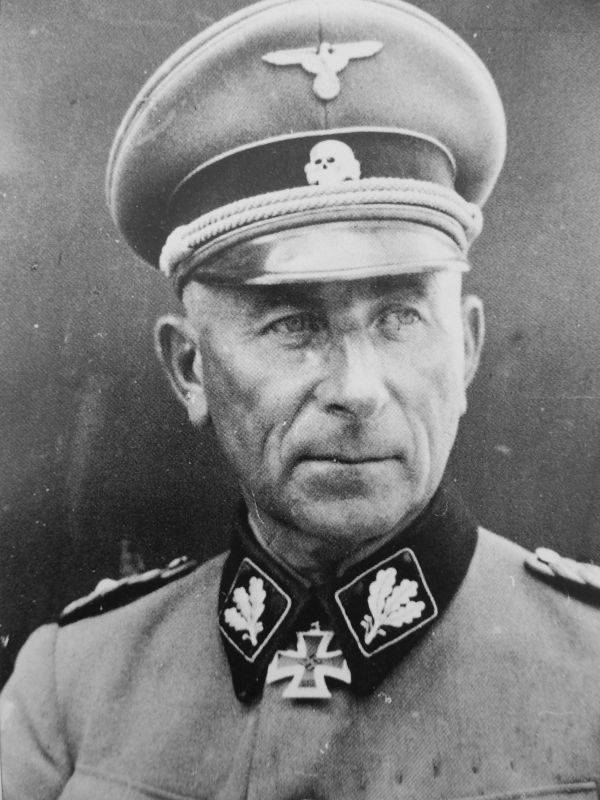
"Pope" of the SS troops, the commander of the SS division "Das Reich" SS Gruppenführer Paul Hausser (1880-1972)
Speed, mobility and power
General Hausser and his assistant Steiner were not pure theorists. They had behind them the experience of the First World War, the creation of assault groups. Steiner commanded assault groups and already then developed a methodology for training personnel, which later became a model for all SS troops.
Based on his military experience, Steiner developed a concept for the development of the armed forces of the future. He believed that the war of the future would be completely different from the First World War. It will be a fast and transient war, where the speed of action, communications, technical equipment and the professionalism of the soldiers will decide everything. The main role will be played not by multi-million armies, but by small mobile, well-armed and specially trained strike units. They will break through the enemy's defenses with quick blows, block it and destroy it.
In 1936, Steiner took command of the SS Deutschland Regiment and began to put his theory into practice. He created combat mobile groups, armed them with submachine guns (automatic), supplied them with a large number of grenades. This increased the unit's firepower.
The SS fighters received colorful camouflage suits, which were not in the Wehrmacht, for which they received the nickname "tree frogs". In the SS troops, they did not increase the distinction between soldiers, non-commissioned officers and officers, but retained iron discipline. It was in the SS troops that the junior ranks addressed the elders only by rank, without adding, as in the army, the word "master". This gave an excellent result, a fighting brotherhood was created. The first SS divisions were distinguished by their high cohesion and combat effectiveness. Steiner later commanded the SS Viking Division, 3rd SS Panzer Corps.
During World War II, Hausser commanded the 2nd SS Panzer Division "Reich", then took command of the 2nd SS Panzer Corps as part of three SS Panzer divisions - "Leibstandart SS Adolf Hitler", "Reich" and "Death's Head". In 1944 he commanded the 7th Army, Army Groups Upper Rhine and G on the Western Front.
Thus, the SS troops could become the army of the future "eternal Reich". Their training system is similar to that of modern special operations forces. At the same time, the Germans created SS troops before they began to form special forces in other countries.
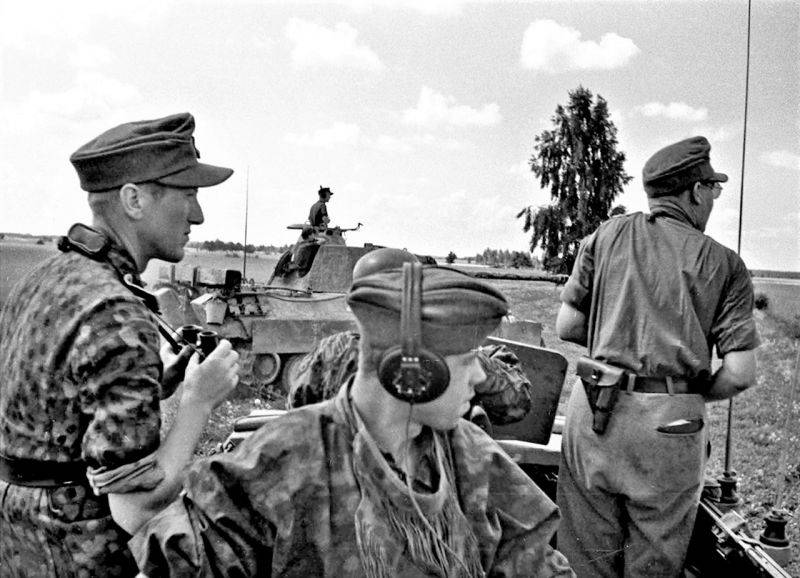
Officers of the 5th SS Panzer Division "Viking" in a communications armored personnel carrier during the fighting near the village of Wilanow in eastern Poland. 1944 g.
Reich saboteurs and special forces
The Germans overtook the whole world in the creation of special forces, sabotage groups.
They were the first to discard the old "knightly" rules of war and merge intelligence with special forces. Today, special forces are an integral part of the armed forces. But at the beginning of World War II, everything was different, sabotage was considered an unworthy, uncivilized method of war.
In Britain, the Special Operations Directorate was created in 1940. Then special actions were called "irregular". Initiative and planning were the business of the chiefs of intelligence in the Navy, the Army, and the Special Intelligence Service. However, obtaining permission for such operations was difficult. The top leadership of Britain enjoyed the fruits of such operations with pleasure, but they were in no hurry to take responsibility for them. Even Churchill resorted to such special operations only as a last resort, often meeting opposition from the Foreign Ministry and the Treasury. It was also necessary to obtain permission from the naval command, and the admirals were always afraid of responsibility.
As a result, the British lagged well behind the Germans in this area.
The Nazis created the secret administration Abwehr-2 in 1938.
The Abwehr trained saboteurs to be deployed behind enemy lines, planned and carried out terrorist acts and sabotage, and trained insurgents to operate behind enemy lines. Units were also formed, which recruited Volksdeutsch - ethnic Germans who were born and raised abroad and representatives of national minorities. For example, Western Ukrainian nationalists.
The Abwehr trained future insurgents, the "fifth column" behind enemy lines. German saboteurs showed themselves well in the Polish campaign in 1939. In 1940, the Brandenburg special regiment was created. The special forces of the regiment, which was then deployed into a division, during 1940-1944 took part in sabotage and reconnaissance operations on almost all fronts. Overall, the operations were successful.
Thus, the Nazis were ahead of the whole world in creating a full-fledged special forces and thereby gained a great advantage over their opponents.
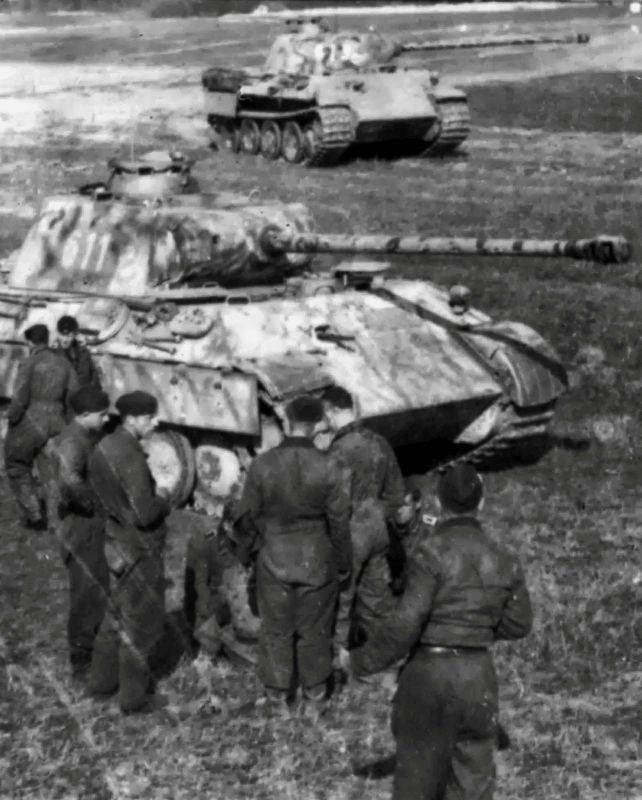
German tankers at the Pz. Kpfw. V Ausf. A "Panther" from the SS "Viking" division at a training ground in Poland. 1944 year
Soviet Russia
It is worth noting that the Soviet Union, which has vast experience in irregular, partisan warfare during the Troubles of 1917-1921, could well have outstripped Germany in this matter. Until the end of the 30s, we had sabotage and partisan detachments in the western border districts, aimed at partisan activities behind enemy lines that invaded our lands. It was precisely determined that the best targets for attacks by flying partisan detachments were the communication routes of the enemy army, fuel depots.
The special forces guerrillas were trained very well: topography, explosives, driving cars, parachuting, tactics of a small group, etc. Weapons, ammunition, explosives, and equipment were put into hiding places. Saboteurs-paratroopers were also trained to be thrown into the enemy's rear. It was planned to create special forces under Soviet intelligence.
That is, Russia was objectively ahead of the Germans in the creation of special forces, and the British, Americans and French were generally far behind in this important matter.
However, in 1937-1938, partisan-sabotage detachments and groups were disbanded, caches and caches were liquidated, many experienced personnel were repressed.
The fact is that there was a struggle for power. Stalin eliminated the "fifth column", the Trotskyists (How Stalin defeated the "fifth column" and saved the people from defeat in the Great Patriotic War). Obviously, the conspirators were also among the military elite. The fall of every Trotskyist, revolutionary internationalist was accompanied by the cleansing of his entourage and team.
The skating rink of repression also went through special units, since their command cadres were selected and placed by the former military elite. And the special units seemed to be a very dangerous tool, suitable for a military coup.
In addition, a new military doctrine was adopted - a war with little blood on foreign territory. The stake is on large mechanized, air and airborne formations. Partisan, sabotage actions on their territory were not envisaged. The idea of the participation of special forces in the offensive did not come up.
True, the war with Finland has already shown the vital necessity of special forces. From the volunteers, they began to create ski units that raided the Finnish rear, fought against the "cuckoos". In 1940, an old military expert, a participant in the war in Spain, Khadzhi Mansurov, proposed creating special units in the army, in each district. His sensible proposal was not supported.
Only the head of the NKVD, Lavrenty Beria, moved the matter off the ground. In general, this person did a lot for the Motherland, but, unfortunately, he was completely blackened, demonized (The black myth of the "bloody executioner" Beria; Part 2). Already before the war itself, in June 1941, Beria ordered the creation of a reconnaissance and sabotage apparatus. Our intelligence star Pavel Sudoplatov was entrusted with this matter.
So, thanks to various "perestroika", by the beginning of the war we did not have a single special forces. And the Germans, having shown intelligence and resourcefulness, used our and their experience (partisans in Africa during the First World War), created the troops of the future, special forces, special operations forces.
Information